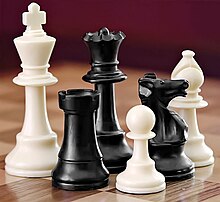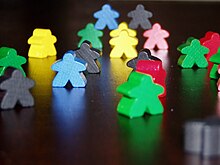Token
A token (also play figure ) is a small object , in a parlor game , either one of the player or part of the team represents. Game pieces are usually placed or moved around on the playing field . Historically, game pieces are actually stones, but also pieces of wood and bone, beans or shells. They are available today in a wide variety of shapes, materials and sizes.
history

The Brothers Grimm note in their dictionary: “Stein zum brettspiel. you can already find them in old soil finds ”. The oldest form are game pieces, which - literally - were selected or cut stones. Even today, children are looking for a suitable stone in the jumping box game . It is said that the original go stones were made of wood. The symbols of the Mah-Jongg stones were carved into bamboo tiles . When Pachisi mussels were mostly used. Finer game pieces can also be made of ivory , marble or expensive wood and decorated with precious metals and stones. The shaping of the game pieces from bread dough described in the chess novella by Stefan Zweig became very well known .
to form
To distinguish each player, the pieces have different colors or shapes. If the game is only intended for two players (for example chess , checkers , mills, etc.) they are often white and black. A scaled-down image or plastic of the object represented by the toy helps to motivate children to play, especially with children. Animals of all kinds, vehicles, fantasy figures but also cards with pictures can represent game pieces. The counters , game markers or markers for short are the game pieces in the form of small cardboard cards, which have been used primarily in strategy games since 1958 .
Designations
The use of the terms token and tokens is ambiguous. Both terms are sometimes used as a collective term for all objects that are moved on the playing field. However, a game piece can only mean a very simple, abstract object such as the checkers' plates . By contrast, a play figure is more often used to denote a stylized replica of a human person or another specific figure with reference to the theme of the game. This includes chess pieces and the accessories of many newer board games .
Game pieces are also referred to with other terms that are typical of the scene, game or region. These include Pöppel , Kegel , Manderl , Männchen or Püppchen . The two names Pöppel and Meeple are of particular importance , as they have established themselves as generic names for a certain shape of game pieces across game, publisher and manufacturer boundaries.
Pawn
The very strongly stylized human figures such as the Halma cones , which are not used by Halma or Mensch ärgere Dich , but also, more generally, other simple game pieces are referred to as pawns or dolls .
The term Pöppel emerged around the mid-1970s and, although not yet listed in the Duden , has become generally accepted in game reviews and descriptions of board games. However, the word clearly comes from the Low German language area in northern Germany. In the high German language area, the term male or male is used. In Bairischen "Manschgal" is said. Until 2001. published gaming magazine The Pöppel revue awarded from 1979 to 1990 the Games Price Golden pawn . Derived from the term pawn, the term "pawn" has also developed, especially in gaming circles: the first unpacking of a game, in particular the removal of game materials from production-related components such as injection molding frames, punching scraps etc.
Meeple
Meeple [ miːpl ] is the name for a special shape of a game piece that came onto the market with the Carcassonne game . They are stylized wooden men in different colors. The name is said to have been coined by Alison Hansel as a suitcase word when playing Carcassonne by merging the words my ( English mine ) and people ( English people ). Since then, the name has been used more frequently in the largest Internet community for board games ( BoardGameGeek ) and has established itself for this type of game piece. Games, publishers and material distributors as well as scientific literature also took up the name.
Gogos
So-called Gogos (English Crazy Bones ) are differently shaped game pieces with which you can play directly. This means that they do not serve as a representation of the player or his team , but are actively thrown or pushed like marbles .
Web links
Individual evidence
- ↑ token. In: Jacob Grimm , Wilhelm Grimm (Hrsg.): German dictionary . tape 16 : Sea life – speaking - (X, 1st section). S. Hirzel, Leipzig 1905 ( woerterbuchnetz.de ).
- ↑ a b Jörg Domberger: How did the child get the name? . In: Freshly played . 2, 2015, p. 33.
- ↑ For example, the Pöppel section on Spielmaterial.de , accessed on March 20, 2017.
- ↑ The golden pawn 1987 . In: The Pöppel-Revue . 11, No. 6/87, January 1988.
- ^ Discussion on Carcassonne. Yahoo Groups, accessed March 20, 2017.
- ↑ Discussion about the “most overused word on here” on Boardgamegeek.com, accessed on March 20, 2017.
- ↑ Mutant Meeples by Pegasus , accessed March 20, 2017.
- ↑ Game pieces accessed on March 20, 2017.
- ^ Alan R. Moon : Designer Perspective . In: Tracy Fullerton (Ed.): Game Design Workshop: A Playcentric Approach to Creating Innovative Games, Third Edition . CRC Press, Boca Raton 2017, ISBN 978-1-138-42767-9 , pp. 157 (English, books.google.de - "Meeples" is not explained in this book.): "On your turn, you draw a tile and play it, and then you can place one of your Meeples or not." "If it's your turn, you draw a piece of terrain, play it and then you can place one of your meeples on it."



